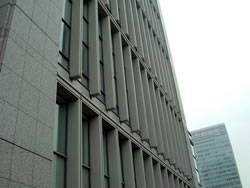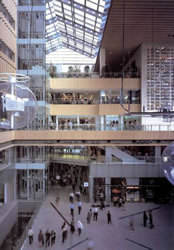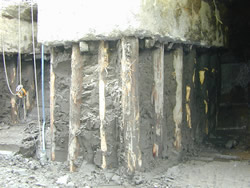Marunouchi Building
Energy conservation around windows
 |
|||
| Exterior with canopies using mullions | |||
 |
 |
 |
|
Mullions protruding to the exterior of the building act as canopies to screen sunlight, while at the same time constituting a unique air barrier system. At normal times, air is blown evenly through orifices inside the pericounter, and heat around the windows can be directly released outside via blind boxes installed at the top of the windows. Blinds are used on sides affected by sunlight, where heat near the windows increases. Here, to ensure that localized heat exhaust can be carried out within the range of surplus exhaust, air balance is controlled at floor level and the most effective direction is selected for heat to be released. In winter, the use of double glazing means that heat insulation increases and heating load near windows is reduced. Even then, heating demand can increase due to cold draughts when the external air temperature is exceptionally low. At such times, cold draughts can be sucked in at the pericounter by reversing the normal blowing direction. As a result, comfort around windows can be maintained without blowing hot air and mixing loss can be reduced.
Natural ventilation system for the atrium
 |
|||
| Natural ventilation system for the atrium | |||
 |
 |
 |
 |
The atrium, measuring 30m×30m×30m in height (approx. 40m at the highest point), serves as a passive space whose main function is natural ventilation based on the principle of sunlight screening. When heat is discharged at the apex, external air generally flows in from the entrance level, increasing the thermal load. However, air conditioning is provided for residential areas by remote release through air supply vents installed below the 3rd floor.
Recycling of demolition waste
 |
|||
| Pine piles from the foundations of the old Marunouchi Building | |||
 |
 |
||
Of the various construction byproducts that arise during demolition, concrete rubble is crushed into aggregate and mainly used as roadbed material, while steel reinforcements and frames are recycled by electric furnace steelmakers. The old Marunouchi Building used approximately 5,500 pine piles for its foundations; these have been converted to chips to provide raw materials for kraft paper, or have been reborn as benches or building blocks, among others.
Previous Building |
 |
 |
 |
 |
 |
 Next Building Next Building |
CASBEE is a method for rating the environmental performance of buildings using Building Environmental Efficiency (BEE) as an indicator, which is based on the results of separate scores obtained for Q-1~Q-3 (Quality) and LR-1~LR-3 (Load Reduction).















 | Copyright © 2008 Institute for Building Environment and Energy Conservation, All Rights Reserved.
| Copyright © 2008 Institute for Building Environment and Energy Conservation, All Rights Reserved.